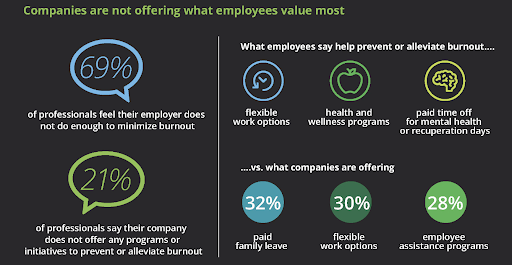Effective worker scheduling is more than just a logistical necessity for businesses — it ensures optimal productivity and streamlines your operations, and it’s a critical factor that impacts the well-being and overall satisfaction of employees.
When creating worker schedules, especially for an hourly workforce, you must consider the physical, mental, and emotional needs of workers. If you don’t, you can end up with discontented, burned-out employees, which can lead to decreased productivity, increased turnover, and other negative consequences.
If you’re searching for a solution on how to prioritize worker well-being but also maintain operational efficiency through effective scheduling, you’ll need to implement strategies that balance the needs of both your employees and your business. We’ll explain everything you need to know — from why scheduling is important to how it impacts your workforce, and tips for how to make the perfect schedule.
Why Creating Efficient Worker Schedules Is Important
Effective worker schedules don’t just benefit your employees. They provide businesses with several benefits:
Enhanced Productivity
Excess pressure, like working long or inconvenient hours, can be draining for employees. If you’re looking for long-term improvements in productivity, create effective worker schedules to optimize your employees’ performance. A well-designed schedule ensures employees have a balanced workload so they’re not overwhelmed, which gives them time to balance their home and professional lives and stay motivated at work.
Reduced Labor Costs
By accurately forecasting labor needs and avoiding overstaffing, you can save money on unnecessary labor expenses. Effective scheduling can even decrease turnover rates, fostering a more stable and reliable workforce and reducing costs related to recruitment and training.
Optimized Customer Service
Balanced worker schedules ensure you have the right number of staff members available to meet customer demands, and employees who have adequate help generally perform better. This keeps your business thriving and your customers satisfied, leading to improved customer service and increased customer loyalty.
Compliance With Labor Regulations
Keeping up with constantly changing federal, state, and local laws governing employee scheduling is crucial for employers. Failing to do so can lead to significant financial repercussions. According to ADP, violations of the Fair Labor Standards Act ranks among the top five most common compliance fines. Effective worker schedules take into account labor laws and regulations, helping you avoid legal issues and penalties.
Easy Tracking of Overtime Hours
While giving your employees the option to work overtime can come in handy, it can adversely affect their mental and physical well-being. If you rely on overtime hours, you can also expect increased labor costs. However, by implementing strategic work scheduling techniques, you can evenly distribute workloads to maximize efficiency and increase your bottom line.
Lower Turnover Rates
Unfortunately, nearly 70% of employees feel their employers don’t do enough to ensure their well-being, with 21% saying they aren’t offered any wellness programs or initiatives. Worn out, unhappy employees are likely to look elsewhere for a new job. But well-structured schedules can help prevent burnout, boost job satisfaction, and ultimately lead to higher retention rates.

Why Worker Scheduling Is Essential for Employee Well-Being
Effective scheduling is not only beneficial to businesses — employees stand to gain from it too.
Predictability and Stability
For hourly workers, knowing when they work and how many hours they can expect is a fundamental aspect of financial planning and stability. A consistent schedule eliminates uncertainties for workers and provides the predictability they need to manage their finances, plan childcare, pursue education, and maintain a healthy work-life balance.
Mitigates Stress and Anxiety
Unpredictable schedules often lead to stress and anxiety among hourly workers. By implementing a stable and predictable scheduling system, you can offer the reliability that helps alleviate this stress, resulting in a happier and more focused workforce.
Encourages Employee Autonomy
Providing hourly workers with a degree of control over their schedules through tools like shift swapping or flexible hours allows them to take charge of their work-life balance. With this autonomy, they can better manage their time and responsibilities.
Prevents Burnout by Allowing Time for Rest
By carefully managing workloads and scheduling breaks, you ensure your employees have adequate rest between shifts so they feel energized and refreshed. Then, they can maintain high levels of productivity and contribute effectively to the team’s success.
Demonstrates Value and Respect
When employers take the initiative to create worker schedules that prioritize and accommodate employees’ well-being, it sends a powerful message of value and respect. Effective scheduling shows a genuine understanding of the individual needs and responsibilities of each worker. When employees feel seen, heard, and appreciated, it increases morale and ultimately helps you attract and retain top talent in the long run.
5 Steps to Create the Perfect Worker Schedule
1. Create an Employee Database
Creating and maintaining a database of employee information significantly simplifies the scheduling process. When you have workers’ designated hours, contact information, availability, and preferences on hand, you’ll be able to handle schedule changes easily.
2. Set Aside Time for Breaks
All work schedules should incorporate designated break and lunch periods so employees have sufficient time for rest. By giving them time to recharge, you’ll foster a healthier and more productive work environment.

3. Ensure Schedule Compliance
Routinely checking work schedules helps employees stick to their designated shifts and follow the rules. Predictability, organization, and oversight are powerful tools against common issues like buddy punching, time theft, and no-shows.
4. Schedule Suitable Employees
By strategically assigning shifts to the most suitable employees, you ensure a consistently high-quality team. Scheduling workers according to their talents, qualifications, and preferences will help you set the standard for everyone else and encourage others to raise the bar.
5. Solicit Feedback
When creating a schedule, seek input from your employees. This will guarantee that you can arrange shifts and days off in a way that accommodates their needs. To make sure workers remain satisfied, be sure to also address any questions or concerns they may have regarding the schedule.
Streamline Your Scheduling Process With Nowsta
It’s clear that employers who prioritize worker scheduling can transform their workplace into a space where every employee’s well-being is taken into consideration while simultaneously boosting productivity and overall company success.
If you want to take the guesswork out of scheduling, Nowsta’s intuitive interface and powerful features allow you to create precise, tailored schedules with ease. By automating time-consuming tasks and providing real-time visibility into staff availability and preferences, Nowsta enables you to efficiently allocate resources while also respecting the needs and well-being of your workforce.
Our platform also offers robust communication tools to facilitate seamless coordination between managers and employees. With Nowsta, you can enhance productivity, reduce scheduling conflicts, and ultimately create a more satisfied and engaged workforce, leading to improved operational efficiency and increased profitability.
Ready to revolutionize your workforce management? Start optimizing your scheduling process with Nowsta today.
